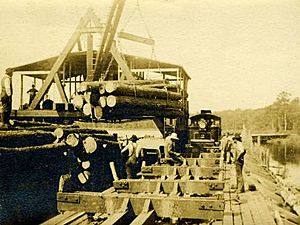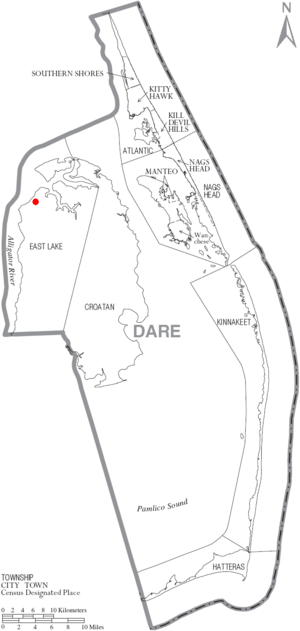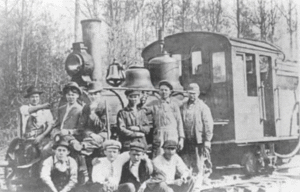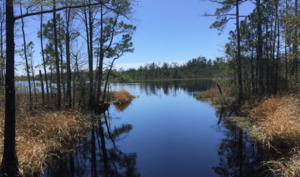Buffalo City, North Carolina facts for kids
Buffalo City was a unique town in Dare County, North Carolina. It was once a busy place known for its logging industry and later for making homemade liquor. The town was located on the mainland, about 19 miles (31 km) west of Manteo. Today, the land where Buffalo City once stood is part of the Alligator River National Wildlife Refuge.
Buffalo City existed for about 80 years, from the 1870s to the 1950s. At its peak in the early 1900s, it had about 3,000 people, making it the biggest community in Dare County. The town had a hotel, a post office, a school, a general store, and even 100 miles (160 km) of railroad tracks. Now, it's a ghost town. All that's left are a road sign, some old rusted rails, and bits of buildings hidden by weeds.
Contents
History of Buffalo City
How Buffalo City Started and Grew
Buffalo City was founded shortly after the American Civil War. The Buffalo Timber Company built the town on the north side of Milltail Creek. Many workers, including African-American laborers and over 200 Russian immigrants, helped build it. Many of these immigrants stayed and worked in the new logging town. They made up about half of the town's population.
The area around Milltail Creek was rich with juniper, cypress, and pine trees. This became the biggest logging operation in Northeastern North Carolina. Loggers earned 50 cents a day. However, they were paid with special aluminum coins made by the company. These coins could only be used in Buffalo City, mainly at the general store.
Buffalo City was a "company town." This means the timber company owned everything and ran the town. It was never officially a city with its own government or police. The company officials were in charge.

On October 11, 1889, Buffalo City got its first post office. Charles A. Whallou was the mail carrier. Over the next ten years, many trees were cut down. The Buffalo Timber Company eventually closed its operations, and the post office shut down in 1903.
In 1907, a new company called the Dare Company bought the forest. They started logging again, and the post office reopened on February 29, 1908. For a short time, the town's name was changed to Daresville. But most people and the post office still called it Buffalo City. The logging industry did very well throughout the 1910s and early 1920s.
About 100 miles (160 km) of railroad tracks were built in the logging area. Mules would carry cut trees from the logging camps to the nearest railroad track. Then, freight cars would take the wood to a transfer station at Milltail Creek. From there, barges carried the lumber to sawmills in Elizabeth City.
Changes and the Town's End
In 1920, Prohibition laws were passed in the United States. These laws made it illegal to make or sell alcohol. Because of this, making homemade liquor became a way for people in Buffalo City to earn extra money. As logging camps started to close in the 1920s, making this liquor became the main way for families to make money.
Many families in Buffalo City made homemade liquor. This liquor was sold in cities across the eastern United States. It was made deep in the woods and moved using the same methods as logging: by mules and boats. A 30-foot (9.1 m) boat called the Hattie Creef carried the liquor down Milltail Creek and across the Albemarle Sound to Elizabeth City. The boat would then return with large amounts of sugar, which was used to make the liquor.
Federal officers, sometimes called "revenuers," began to stop the illegal liquor making in Buffalo City. Some men from the town were sent to jail.
When Prohibition ended in 1933, Buffalo City's economy was badly affected. With less money from making liquor, people tried to focus on logging again. However, most of the good timber had already been cut. The sawmill kept running for about 20 more years.
In the 1940s, diseases like cholera, typhoid, smallpox, and the flu spread through the town. These diseases, along with the lack of work, caused Buffalo City's population to drop to only about 100 people. The sawmill finally closed in the early 1950s, and the town was abandoned.
The Richmond Cedar Works company bought the land around the abandoned town. Later, they sold it to Prulean Farms. In the 1970s, Prulean Farms used the land for farming. In 1984, the United States Fish and Wildlife Service bought the land. They turned it into the Alligator River National Wildlife Refuge. This refuge is now a safe home for animals like black bears and the endangered red wolf.
Town Layout
Buffalo City was built around its main street, Buffalo City Road. This was a 10-foot (3 m) dirt road that went from East Lake to Milltail Creek. Three shorter roads, about 150 feet (46 m) long, ran across the main street. A fourth road curved around the north side of town.
Because the ground was soft and muddy, the streets were covered with sheets of wood and sawdust. This helped prevent people from sinking into the mud. The buildings were made from wood that the lumber company couldn't sell.
Homes were painted either red or white. Red homes were for white workers, and white homes were for black workers and immigrants. A railroad track was built on Buffalo City Road. It brought lumber from the logging camps deep in the forest. Buffalo City did not have a police station or elected leaders. Instead, a stockade (a simple jail) was built in the center of town.




